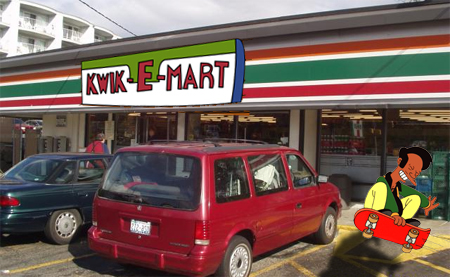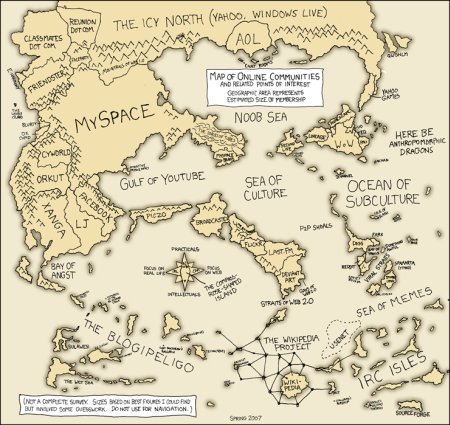von Roland Hachmann | Mai 5, 2007 | Blog, Digital Culture, Digital News
Call me old fashioned, or what. But the new timeshifting function I got, purchasing that digital TV adapater for my laptop, still needs some getting used to.
It’s a fantastic luxury to be able to just „pause“ live TV when you’re getting a new beer or something like that. But the thought of being able to pause live TV is so strange, that I still forget about it most of the times. And then I am mad at myself, returning to a well progressed movie, knowing I could have paused it… Oh well…
Next thought: If I consider myself quite adapt with new technologies – how long will it take for the average German TV viewer to „routinely pause TV“?
von Roland Hachmann | Mai 1, 2007 | Ad News, Blog, Digital Culture, Digital Marketing, Digital News, Marketing, Mobile Marketing, Online Advertising, SEO / SEA, Social Media Marketing
I am a big fan of Joe. I regularly read his blog and I really enjoy his podcast, listening to it while driving to work (it is really motivational and inspires me a lot, which I enjoy in the morning!).
And I have (finally) read his book. I am very late writing about the book. Why am I writing about it nevertheless?
More than a year ago, Joseph Jaffe came up with a concept he called „UNMTPNM„: Use new marketing to prove new marketing. He launched this idea in order to promote his (then) new book:
Life after the 30-second spot
Energize your brand with a bold mix of alternatives to traditional advertising.

I decided to take part, as I liked the idea of how he wanted to start word-of-mouth this way. Now I want to write the review. It’s late, but I thought better late than never. And this way, Joe gets a new mention during a time, when everyone is already writing about his new book, which should be coming out some time in the middle of this year. Which, by the way, extends on one of the thoughts what new marketing can look like in the future. So here is my review, apologies, again, for it being so late.
His main conclusion throughout this book and his blog and his podcast is always the fact, that traditional advertising is by far no longer as useful as it used to be. Or as he puts it: the 30-second spot has outlived its usefulness.
So what’s in the book? There are 3 main sections:
Section I – The Problem
In this section Joe describes the current state of the media landscape. How mass media are dying due to the fragmentation of media and increasing consumer resistance towards clutter and power of media choice.
This chapter lays out the foundation for the rest of the discussion. By now these things are common knowledge and widely discussed everywhere. Yet, in 2005, when the book was printed, these points were heavily debated everywhere. (And, by the way, in Germany these points are still relevant, considering the fact that we’re usually lagging some time behind.)
Section II – The Solution: Re:think Four Fundamentals of Marketing
In this chapter, Joe is Re:thinking four main areas that need, well, rethinking. These are: the changing consumer, branding, relevance of advertising and the agency/client situation. These chapters are a „theoretical basis“ for the approaches in the third section and . A nice idea: you cannot read chapter 10 within the book. You will have to download the pdf or the mp3 file (to listen to Joe read out that chapter for you).
Section III – 10 Approaches that are transforming the marketing and advertising games
The approaches expanded on in this section are: the internet (of course…), gaming, on-demand viewing, experiential marketing, long-form content, communal marketing, consumer generated content, search, music – mobile and things that make you go mmmm, branded entertainment. In essence this covers examples for all the buzzwords, that companies have been experimenting with in the last couple of years.
Comments on the Contents
The first chapter is rather preaching to the converted and sometimes a bit over the top. The facts might be true, but sometimes you get the feeling as if the world is going to stop, the way Joe writes about the end of „old“ marketing. For anyone reading the book now, the first 60 pages are common knowledge (or should be!). But as a summary on the situation it is not bad.
The second section is the one for me, that had the most juice in it. Purely because these are the backbone thoughts on how to think about marketing in the future. And – in contrast to the third section – these thoughts are more likely to be relevant even in a few years time. The third section covers many examples per approach, but even looking at them now, some already seem antiquated (which doesn’t make them less true).
Comments on the Style
His style of writing is rather conversational. One of the many examples:
„… in a survey conducted by the consultancy Emergence, a grand total of 0 percent (that’s zero, none, nada, squat, zip, nil) of those quizzed…“
That makes it awkward to read sometimes, especially considering it is a book, not a blogpost or a podcast. It is almost, as if he dictated the script for someone else to type it. But, speaking of which: keeping Joes way of talking in mind, you can almost read the book and hear his voice saying these things.
So should you buy it? I think it was Joe himself who once said: buying a book these days is like getting „the t-shirt“. An „I have been there“ thing at times when content itself is readily available everywhere… You could follow Joe’s thoughts through his blog, his podcast, by going to crayonville, etc. But this is the one source that best and most complete summarises what Joe thinks, writes and says about new marketing.
So while the book will not completely stay relevant in the next couple of years, I think it is a very valuable basis for re:thinking marketing and advertising. For anyone who read about the changing media landscape, wanting to find out how to possibly react (and not having had their agency recommend things already, which they should have done), read the book. Skim-read the first section, this should be no news to anyone by now, focus on the second section for strategic visions and get some ideas of what new marketing can look liek from the last section.
Don’t forget: you can order it online. (Any commision amazon might yield will go to Joe, as I copied this link of his website.)
von Roland Hachmann | Apr. 3, 2007 | Ad News, Blog, Digital News, Marketing
Not sure, if this is true, but I’ll help spreading the word, since I like the idea:
A deal is pending between the world’s largest gas station company and Fox to temporarily convert 11 7-Elevens across the United States into Kwik-E-Marts to promote the upcoming Simpsons Movie. I’ve taken the liberty of creating an image of what this might look like if the event goes through, and let me be the first to say this is completely awesome.
You’ll also be able to buy items inspired by the show, like KrustyO’s cereal, Buzz Cola, and iced Squishees. As soon as we find out exactly if, when, and where this happens, we’ll be sure and let you know.
Here is what it could look like, according to Justin Glow:

(found here.)
von Roland Hachmann | März 22, 2007 | Ad News, Blog, Digital Marketing, Digital News, Online Advertising
Doubleclick apparently just published a study on the effectiveness of video ads. Which is fine, it’s a new ad form that needs to be scrutinized. But the first couple of findings really state the obvious in my opinion:
When it comes to grabbing the attention of Web surfers, advertising distributed via online video handily outpaces static image ads…
Well, of course. Anyone could have guessed that, really.
The second fact they find is equally obvious:
It predicted companies that invest in online video advertising are likely to see significant results.
Wow, what a coincidence. I bet they’re more expensive, too…
I know, I know. You need this kind of study in order to really convince clients (or rather: their bosses) that video ads justify the budget spent on them. But hey, it sounds all the more trivial to me.
Only one thing makes me think:
„It’s a mistake for advertisers to assume that all they should do is take their television ads and move them to the Internet,“ he said. „I expect that the most effective video ads are the ones that compel the user to engage with them and initiate the advertising. Our clients are now mixed about whether their ads should play with or without user initiation… I think the best practice is to create the type of advertisements that users are going to request to see and initiate.“
I agree, that you shouldn’t just put your TV spots online. Rather, produce something truly interactive, with links in it. (Which could look like this.)
Also, the videos should wait to be activated. Neither should they start running with full sound right away (consider office situations…). The best I have seen so far were looping video ads without sound, but with a very visible sound „on“ button.
von Roland Hachmann | Jan. 30, 2007 | Blog, Digital Culture, Digital News
It’s this blogs 2nd Birthday today. Yes, Web Jungle is two years old. I am rather excited about this, as it doesn’t appear to me as if I have been working&writing on blogs for so long. I can still remember having started on the old blogger.com space: http://jungleweb.blogspot.com/
Then, when I noticed I would indeed continue with blogging, I moved everything to my own domain with a much more flexible blogging software. So I moved to web-jungle.com and wordpress. Now this again is even more than a year old.
I have blogged with wordpress since September 2005. Since then I have abandoned the blogspot location. Interesting, that my content is still there – talking about digital trash!
Looking around, I notice that some blogs are already a few years old (but still only up to 6-7 years at the most!!), and I wonder, if blogs will, from now on, continue to be part of some peoples lives? Will I still blog in 5, 10 or 20 years time? How big would my archive of information be? What wealth of information and links would it provide?
What wealth of information and links would generally exist in 30 years, if bloggers and content-/link-platforms continue they way they manage content these days?
All these are faszinating thoughts, theoretical in nature, as we’re all going to experience the effects of the web at the same time, with lot’s of people putting out theories, with only a few really succeeding in implementing good platforms and everybody learning and adapting as they go along.
I already enjoy the ride, how about yourself?




 Wo ich sonst so bin...
Wo ich sonst so bin...